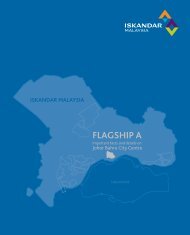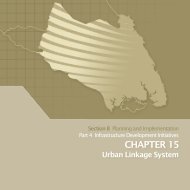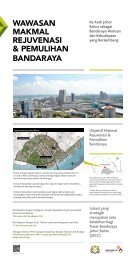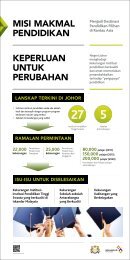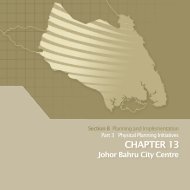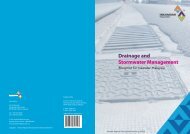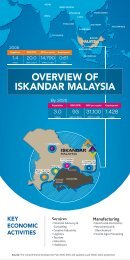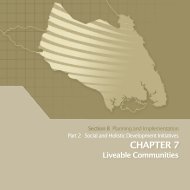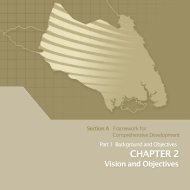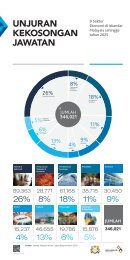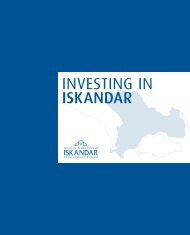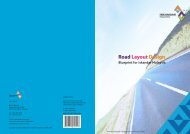CHAPTER 14 - Iskandar Malaysia
CHAPTER 14 - Iskandar Malaysia
CHAPTER 14 - Iskandar Malaysia
You also want an ePaper? Increase the reach of your titles
YUMPU automatically turns print PDFs into web optimized ePapers that Google loves.
SECTION B<br />
PLANNING AND IMPLEMENTATION<br />
H. Water Supply Master Plan<br />
▼ Development Option<br />
To overcome the projected water shortage, new sources need to be<br />
found and new treatment plants need to be developed. Based on the<br />
projected increase in demand, a treatment plant with a capacity of<br />
100 million litres per day should be built to meet demand for water in<br />
2025. Other alternatives such as rainwater harvesting and exploitation of<br />
underground water resources should be explored.<br />
<strong>14</strong>.7 Water Resource Management and Alternative Sources<br />
SJER will adopt an integrated water management system where water<br />
supply and use will be viewed as an integrated cycle. Sources of water,<br />
which include underground water sources, rivers, water catchments<br />
area, lakes and rainwater, are to be is conserved whilst wastewater<br />
from sewerage treatment plants and drainage systems is to be recycled<br />
for suitable purposes.<br />
Figure<strong>14</strong>.1: Concept of Integrated Water Management<br />
KEY DIRECTION<br />
UI 5 : Sustainable use of water resources i.e implementing<br />
measures for more efficient use of water and by encouraging<br />
water recycling and rainwater harvesting<br />
A. Water Sources<br />
Apart from conventional water supply for domestic use from public<br />
distribution system by relevant agency, other potential sources of<br />
water need to be exploited, in particular, rainwater. Guidelines for<br />
incorporation of rainwater harvesting in individual buildings have been<br />
formulated.<br />
B. Rainwater collection and water recycling<br />
Rainwater is collected from downspouts connected to the roof gutters<br />
of a building. A simple device called a roof washer diverts the initial flow<br />
of the rainfall into a storage tank.<br />
Table <strong>14</strong>.12: Projected Water Resources From Rainwater harvesting<br />
Pipe Water from<br />
Water supply<br />
Agency (SAJ)<br />
Rainwater<br />
Recycled Water/<br />
Grey Water<br />
Year 2003 2005 2010 2015 2020 2025<br />
Rainwater<br />
Harvesting<br />
(mld)<br />
18.7 23.0 26.2 32.5 40.7 51.0<br />
Source: SJER CDP 2025<br />
DOMESTIC USE<br />
Drinking Water<br />
Kitchen Use<br />
Bathing<br />
Washing<br />
DOMESTIC USE<br />
Bathing<br />
Washing<br />
Toilet FLushing<br />
NON-DOMESTIC USE<br />
Gardening<br />
Municipal<br />
Landscaping<br />
Car Washing<br />
DOMESTIC USE<br />
Toilet Flushing<br />
NON-DOMESTIC USE<br />
Gardening<br />
Municipal<br />
Landscaping<br />
Car Washing<br />
Water<br />
Use<br />
Water<br />
Sources<br />
Waste<br />
Water<br />
Sewerage<br />
Treatment Plant<br />
Drains, Retention<br />
Ponds and<br />
Canal System<br />
River System<br />
Figure <strong>14</strong>.2: Use of Gutter for Rainwater Collection in<br />
Residential Building<br />
Gutter to to collect collect rainwater<br />
rainwater<br />
Gutter to collect<br />
rainwater<br />
Gutter to collect<br />
rainwater<br />
Source: SJER CDP 2025<br />
Source: SJER CDP 2025<br />
<strong>14</strong> - 8



